southwestern patterns in rugs and carpets
History and Cultural Significance of Southwestern Design
Southwestern patterns in rugs and carpets have a rich historical origin that can be traced back to Native American tribes such as Navajo, Hopi, and Zuni. These Indigenous groups have a long-standing tradition of creating intricate designs that reflect their cultural heritage and connection to the land.
The origins of Southwestern patterns can be found in the ancient traditions and beliefs of these tribes. The Navajo people, for instance, are renowned for their exquisite weaving skills, passed down through generations. Their rugs and carpets often incorporate geometric shapes, bold colors, and symbolic motifs inspired by nature.
Similarly, the Hopi tribe is known for their distinctive weaving style characterized by symmetrical patterns and earthy tones. They draw inspiration from their spiritual beliefs and traditional ceremonies to create designs that evoke a sense of harmony and balance.
The Zuni tribe has also made significant contributions to the development of Southwestern patterns in rugs and carpets. Their designs often feature intricate symbols representing elements like rain, fertility, or sacred animals. These patterns not only serve decorative purposes but also hold deep cultural meaning within the Zuni community.
Throughout history, these Native American tribes have influenced each other's artistic techniques and knowledge about pattern-making. As a result, Southwestern patterns have evolved over time while still maintaining their unique aesthetic qualities.
In recent years, there has been a resurgence of interest in Southwestern patterns globally. Many interior designers and collectors appreciate the authenticity and beauty embedded in these handcrafted rugs and carpets. By incorporating them into modern spaces, individuals can honor the rich cultural heritage of Native American communities while adding a touch of warmth and character to their surroundings.
Overall, the historical origins of Southwestern patterns reveal a fascinating journey rooted in Native American craftsmanship and spirituality. From the Navajo's intricate weavings to the Hopi's harmonious designs to the Zuni's meaningful symbols—these tribal influences continue to inspire contemporary artists worldwide. Embracing these timeless patterns allows us to connect with a vibrant history and appreciate the remarkable artistry of these Indigenous cultures.
